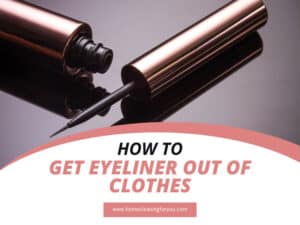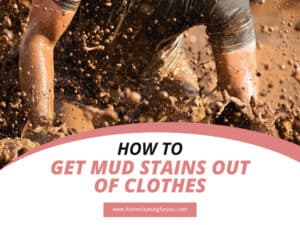Quick & Easy Tricks to Remove Stubborn Lint from Clothes
“How to remove lint from clothes?” is not a new question, yet it is a frequently asked question when it comes to cleaning clothes of all time. Imagine taking your clothes out of the washing machine, and they are covered with lint fibers; that scene might be the worst.
But you don’t need to worry about that anymore; I will help you with your big concern. Not only the ways to clear them out, but I will also provide you with some solutions that allow you never to see them again. Scroll down for more information!

Where Does Lint Come From?
Basically, lint is the broken, stray, tiny fibers from your clothes. After a time of using, washing, and wearing your clothes, those tiny fibers loosen up and might cling onto the other clothes when you do the washing.
Lint is mainly “produced” from polyesters, cotton, or wool. Other types with elastic fibers (spandex/lycra) or non-woven polyolefin are more resistant to lint.(1) Therefore, you should keep your clothes that are made of cotton or polyester away from the others.
Here are some lint shedders or attractors you might want to refer to and have the proper strategy to deal with them later.
Those “broken fibers” affect your clothes’ look; they can even harm people with lint allergies. (2) So, using your hand or patting might not be enough to clear all the lint off.
Take These 15 Tips To Get Rid Of Lint On Your Clothes
And now this is the section you have been waiting for! You don’t need to worry about lint-clinging on your clothes anymore; I will share with you every way I know to help you out! Put your clothes on a tabletop, and let’s get scrolling!
1. Lint Rollers

They are basically anywhere: supermarkets, online shops, pet or fabric stores. You just need to find one (big/small size based on your preferences) and follow my guidance.
How To Do:
You should do these steps to receive the best result!
- Step 1: Take off the plastic seal on the tube.
- Step 2: Follow up-and-down movement to roll the tube all over your clothes.
- Step 3: Once you see it is loaded with bobbles/lint and less sticky, take off that dirty layer to unseal the next sticky layer.
- Step 4: Simply redo all the steps until you see your garments are clean and clear.
Pro tips: To reuse your lint rollers, you can find the replacement roll of sticky sheets. Otherwise, buying a new roller is completely fine.
But what if you have no lint roller, you can wrap packaging tape around a rolling pin in a spiral and use it as a substitute. Remember to fasten the smooth side to the pin and the sticky side should face outward.
2. Tape (Or Contact Paper)

The tacky ability of tape can help your lint collecting work become much easier. You can either use packaging or scotch tape to do this trick. And there are steps you should follow to get things done.
- Step 1: Wrap a piece of tape around your finger (with the sticky side contact with your garments’ surfaces, parallel with the fabric grains). Remember to use only a moderate amount only.
- Step 2: Dab the lint-clinging areas on your clothes’ surfaces with your finger.
- Step 3: Change the tape when it becomes less sticky and full of lint.
Pro tips: You can cut pieces/some strips of tape, then stick them on your clothes.
Do some good patting for them to stick evenly. Then peel the tape off after a few seconds. The contact paper can be used in a larger piece to deal with lint on a larger area.
This is the correct way to use tape to remove lint on your clothes!
3. Lotion
Surprisingly, you can use lotion to remove large lint from your clothes. The trick is so easy to do, and this is how things will be done.
All You Need:
- Lotion (any type you have)
- Your hand
How To Do:
And that’s all you need; these straightforward steps can help you to do it properly.
- Step 1: Put a fingertip amount of lotion onto your palm and apply it evenly.
- Step 2: Gently wipe your bare hand on your clothes, and you can take up the lint or pet hair in a snap.
Easy-peasy tip to remove lint from clothes with lotion you should save for yourself.
4. Pumice Stone/ “Sweater Stone”

Pumice stone has a porous, abrasive texture, and that will help with collecting lint. Ensure to move along the grain of your clothes to avoid shredding even more fibers. Don’t be too vigorous and rub one area for too long (you might tear your clothes).
After all, you can use the lint roller or tape to take off the lint bobbles out of your clothes.
Notes: Don’t use a pumice stone on wool/cotton items, and some are made of delicate fibers like silk or satin.
5. Hairdryer
This utensil is helpful when you have little time, and the lint fibers amount is significant. It is because you can find the hairdryer in your house anytime.
You Should Prepare:
- Soft-bristles brush/dryer sheet/pumice stone
- A hairdryer
How To Do:
- Step 1: Hang up your clothes.
- Step 2: Switch your machine to high cool-blowing mode.
- Step 3: Do the brushing with any utensils (brush/dryer sheet/pumice stone) above and the blowing at the same time.
The lint will be partly pushed back to the fibers or blown out.
6. Dryer Sheet

Simply use a piece of dryer sheet to rub the garments’ surfaces lightly; the annoying lint can stick to the sheet just as iron dust is attracted with a magnet. You can both use a dry or a damp dryer sheet to accomplish the task and this utensil is also one of the cheapest.
7. Hairdryer + Dryer Sheets
This method is a combination of hairdryer and dryer sheets. You can refer to this way to utilize the benefit of these utensils and to bring a wanted result (especially on fuzzy clothes).
You Will Need:
- Water
- Dryer sheet
- Hairdryer (+cool setting)
How To Do:
It would not be very complicated, you should look at these steps:
- Step 1: Dampen your prepared dryer sheet with fresh water. Ensure not to make it soaked.
- Step 2: Move the dryer sheet along your garments, at the same time, continuously let the hairdryer blow directly following that.
Keep doing the work until your clothes/garments are clear from lint.
8. Velcro

The rough side with the small hooks or velcro is super practical when it comes to clearing lint. Use the velcro just as you use a brush, move it straightforward in one direction only to avoid scratching your clothes.
Use a lint roller or tape afterward to remove the lint you have just scraped off.
9. Shaving Razor
Multi-blade or single-blade razors both work, but if you are afraid of accidentally cutting your clothes or your fingers, I suggest using the multi-blade with a handle to avoid any unwanted situation.
How To Do:
You should follow my guidance strictly to do the task quickly and flawlessly.
- Step 1: Start at the top of your garment slightly and gradually move it along your piece.
- Step 2: Check for the lint fibers stuck between the blades after each stroke and take them out first. It will help you to do the next stroke smoother.
- Step 3: Continue doing until you take care of the whole garment.
Notes: With a single blade, you should be careful when holding it. Just keep it at the angle and move the sharp blade side slightly on the surface. The lint can be skimmed out just like that.
10. Electric Lint Shaver

Prepare an electric lint shaver (one that uses battery power will be better), and you have done it halfway.
Next, you can gently move the shaver all over the clothes/fabric surfaces. After being satisfied with the result, open the lint compartment on your shaver and remove all the fibers/hair there.
The best guidance on using an electric lint shaver to remove lint from clothes.
11. Damp Sponge/Scouring Pad
You can use the rough side of a damp scouring pad/sponge (+water) to scrub or wipe the garments/fabrics gently. Ensure the scouring pad/sponge is not soaking wet.
You should follow one straight direction from the top to the bottom to take out the lint. Remember, don’t rush or be too vigorous; just do it gradually from a small section out.
12. Lint Brush/Cloth Brush

The fuzzy pad is the main difference between this type of brush and a regular brush. Here are the steps to use this brush properly.
- Step 1: Gently rub the clothes/fabric surfaces following one direction only. Remember to cover every inch of them.
- Step 2: Use a lint roller or tape to remove the left lint.
Alternative: You can use a rubber-bristles brush to remove bigger lint, hair, or particles.
Note: With some other tough fabric (wool/peacoat/corduroy), you can apply more vigorous force to get rid of the lint.
13. Rubber Gloves

Everyone can have rubber gloves or dishwashing gloves (preferable) prepared in the kitchen, just take a pair of them and get to work.
- Step 1: Wear the gloves you have found.
- Step 2: Slightly move your hand all over the clothes’ surfaces (from the top to the bottom). The lint, pet hairs, and other light fibers will stick to your rubber glove.
Continue doing this step until all the lint and hair have formed a clump.
- Step 3: Take the lint-hair bobbles out of your clothes or gloves’ surfaces with your finger/ a tape/ a lint roller.
14. Nylon Sock/Pantyhose

Like using rubber gloves, you just need to put your hand into a nylon sock or pantyhose (your fingers have to touch the end of the sock) and rub the garments/clothes.
The mechanism of this way is to increase the static on the sock’s surface so that the lint or hair can stick to it.
Move your hand all over the clothes/garments until you can barely see any lint left.
15. Rewash Your Clothes With Only Water

This way is effortless and let’s see how things will work!
- Step 1: Simply put your clothes back to the washer immediately if you see lint clung to them. Set the mode to light/normal wash cycle. Don’t put any detergent this time and just set the washing machine as you usually do.
- Step 2: Once taking them out again, do some good shake (so you can knock off the leftover lint a bit).
- Step 3: After all, toss your clothes into the dryer (delicate/cool cycle) and let the machine do its work.
16. Anti-Static Spray
If you don’t have time to do the rewashing like the above method, you can use this way as an alternative. It will help to prevent lint from clinging to your clothes effectively.
You Will Need:
- Anti-static spray
- A lint roller/dryer sheet
How To Do:
The process can be done within a few minutes!
- Step 1: Spray some of the liquid onto your clothes.
- Step 2: Use a lint roller/dryer sheet to take the lint off.
17. Vinegar/Liquid Fabric Softener

It is a secret tip that no one has told you yet. You should pour in a quarter cup (¼ cup) of white vinegar into the washer.
And there are three options to do this:
- First, you can pour the liquid directly on the rinse cup before washing.
- Second, you can also consider putting that amount of vinegar during the “rinsing process”.
- Alternative: You can use liquid fabric softener/vinegar (1 cup) and wash your garments again thoroughly.
Besides the effect of removing lint, this vinegar application can help to soften and whiten your clothes (or other things). It can also eliminate the unpleasant odors that might be left in your machine from previous washing.
Don’t Want To See Lint On Your Clothes Again? Do Like This!
It is always easier to prevent than fixing the problem. To avoid having lint on your clothes repetitively, you should refer to some suggestions here and apply them in the future.
4 Tips To Prepare Your Clothes
First, you should notice some tips related to clothes before and after washing. Make sure to do a good preparation so you won’t need to regret later.
1. Wash Your Clothes Inside-Out
If lint is easy to shed when you traditionally wash your clothes, now I suggest you wash them inside-out. Do it with both lint-magnets or lint-producers, and you can see the result right away.
2. Black Clothes Should Not Be Washed With The “Culprits”/Lint Shedders
No matter what material they are made from, if there are any lint clings on the black clothes’ surfaces, they will be very apparent and might ruin the look of your clothes.
3. Always Check The Pockets And Empty Them
Before starting the washing process, this tip should be done because some delicate fabrics such as cotton tissues or paper are more vulnerable than regular shirts or pants. They can easily be shed and cause lint all over your washing bin.
4. Don’t Overwash Your Lint-Producing Clothes.
Washing your lint-producing clothes for too much can bring adverse effects; the forces from the washing process can create more lint.
If you are afraid of smell, hang those clothes after wearing them on the clothesline and air dry them naturally. Sunlight and wind will help you with deodorization.
4 Washing Tips You Should Follow
After knowing clothes’ tips to avoid lint, some washing tips here can also help you in future cleaning work.
5. Detect Lint Shedders And Separate Them Before Washing

It will be much easier to separate the potential “culprits” from the “victims” when washing up. Some “culprits” can be said to be cotton flannel, towels, or some things I have suggested above.
6. Clean The Lint On Clothes Before Washing

If you put your lint-clinging clothes into the same washing bin with other garments, those lint fibers can move and affect the others, making the problem worse.
Because of that, try some quick tips to remove the lint above and clean the stray fibers up before washing them.
7. Clean The Washer’s Drum After Cleaning Lint-Producing Garments

Lint can be left inside the washer’s drum after you wash lint-making clothes, which can cling to the other clothes when you wash them up next.
Those annoying fibers might be stuck at the top rim of the drum (old washer), or in the agitator of your modern, top-load machine ( at the back of front load types).
Therefore, do a quick wipe or simply set the water cycle (without clothes) inside your washer; the drum will be clear from lint in snap.
8. Hand Washes Your Clothes Can Help To Reduce Lints.

It is a simple way to reduce stray lint falling off from your clothes after every time you wash them. The force from your hand is not as strong as the centrifugal force in the washing machine drum, which reduces shedding lint from your clothes’ fabric.
But hand washing clothes are sometimes inconvenient that might make you feel discouraged and give up from the start.
To encourage yourself, let’s start with your expensive pieces first! At least you don’t want your expensive investment loaded with lint, do you?
5 Drying Tips To Help You Deal With Lint
Drying steps are also important and they can surely help you get rid of stray fibers on your garments.
9. Do Some Good Shake Before Drying (With Dryer)
It basically helps you partly push loose lint out of your clothes dry more efficiently.
10. Use Dryer Sheets For Drying Process (In The Dryer)
These sheets will help with reducing the static and loosen lint from clothes. I suggest using ½ sheet for small loads and a whole one for an average load.
11. Always Remember To Clear The Lint Trap Every Time After Drying (With Dryer)

There is a special tray inside your dryer that is designed to contain lint fibers from your clothes. After every cycle, it will be loaded with lint, and it’s time to toss those things away.
It is not challenging to clear this tray; either knocking it directly onto the trash bin or using your own fingers to scoop them out will work. Then, you should do this as suggested to prevent lint from coming back in the following cycles.
12. Apply Dryer In “Air-Only” Mode.
This particular “air-only/air-fluff” mode only uses room-temperature air (not heated) to dry your clothes. Therefore, under cool air, the static on your clothes will lessen, and the lint will fall off, and the lint screen (inside the dryer) will catch those stray fibers effectively.
Refer to this introduction and see several suggested ways to eliminate lint!
13. Dry Your Clothes Naturally And “Classically”.

You can just dry your clothes by hanging them on a clothing rack/line and letting nature do the rest. The wind can help blow or knock out the clingy lint, while sunlight will help with deodorization and sanitizing.
3 Other Tips To Reduce Lint Fibers
To efficiently remove lint from your clothes, you should take care of some more things below.
14. Regularly Clean Lint In Your Living Areas.

Lint fibers are not only clung to your clothes; they might lay on your desks/beds, in your car, or inside the closet. Always prepare a lint roller/brush near those places/things and do a quick cleaning to avoid lint coming back to your clothes.
15. Don’t Put Lint Shedders Near The Lint Attractors In The Closet.
Lint can quickly move from the lint shedders like sweaters/bathrobes/cotton clothes to linen clothes or other lint attractors. Keeping them away from each other will help a lot. And you should keep light-colored garments away from the black ones, too.
16. Using Steamers Sometimes To Hold Lint Back.

If you don’t have much time to wash all the lint-loading items, besides using only the lint rollers or brushes like usual, try applying the clothes steamers. This kind of machine works magically in increasing the static on your clothes’ fibers and helps to hold back the loose lint.
FAQs
There might be many other questions around this topic, and if you haven’t found some of your wanted answers yet, you can read this question-and-answer section to find one more time.
Roll Up Your Sleeves And Get Things Done!
You do not need to be concerned about lint appearing and ruining your clothes’ look or your health anymore. I have recommended several ways to get rid of lint clinging to clothes/garments and clean lint efficiently in the dryer or washing machine.
I hope you find my sharing tips helpful and can assist you well in the future. If you have tried any of my suggestions or have other exciting recommendations, please share them with me in the comment section. Your contribution will become a great motivation to me.

References
- En.wikipedia.org. 2021. Lint (material) – Wikipedia.
- Advanced Allergy & Asthma Care. 2021. Dust Allergies – Advanced Allergy & Asthma Care.







Samantha Lee
Head Cleaning Expert
Expertise
Professional Home Cleaning, Green Cleaning Techniques, Stain Removal & Fabric Care, DIY Home Maintenance & Organization, Sustainable Cleaning Products, Home Care for Busy Lifestyles
Education
University of Denver
Samantha Lee is the Head Cleaning Expert at HomeCleaningForYou.com, specializing in eco-friendly home care. She holds a Bachelor of Science in Environmental Science from the University of Denver, focusing on sustainable cleaning solutions.
With expertise in green cleaning, stain removal, and DIY home maintenance, she helps homeowners keep their spaces fresh and chemical-free. Samantha has been featured in lifestyle publications and has partnered with brands promoting natural cleaning products.
She also shares practical tips through her blog, online courses, and workshops. Passionate about sustainability, she enjoys testing new eco-friendly cleaning methods and spending time outdoors.